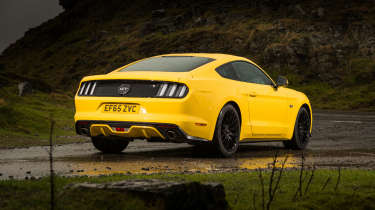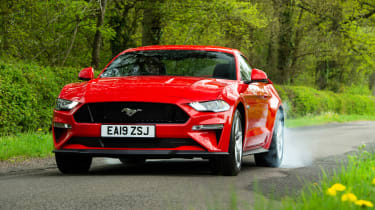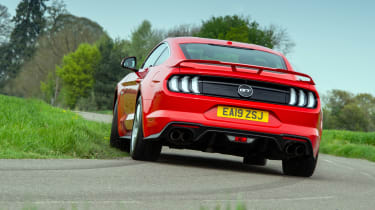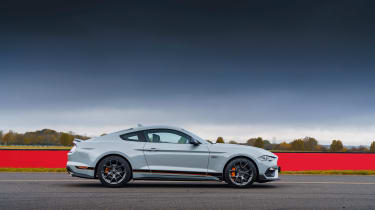Used Ford Mustang (S550, 2015 - 2023) review – Ford’s V8 muscle car for £20k
The S550 appeared ten years ago as a more sophisticated kind of Mustang, in right-hand drive and with the job of tempting European sports car buyers.
Some cars trade on charm and not much else, and for a while the Ford Mustang fell into that category. Its brawny V8 and quintessential muscle car proportions (we’ll ignore the 1979 Fox-body version) are magnetising to US buyers, but to succeed in Europe, a one-trick pony car just won’t do.
Ford recognised this with the sixth-generation S550 model, which when it arrived in 2015 offered right-hand drive for the first time and finally gained a more sophisticated chassis to manage its power. Debuting a decade ago, S550 Mustang V8s can now be had for the price of a new small family hatch.
Ford Mustang (S550) in detail
That’s not to say it isn’t big, brash and slightly ponderous at times. It’s still a Mustang at heart, only with more substance beneath its bulging, sinewy exterior. As you sit far back in the chassis with the bonnet stretching out up the road ahead, the sixth-gen Stang loses none of its sense of occasion – and that’s before you’ve fully extended the 410bhp 5-litre DOHC ‘Coyote’ V8. If you’re used to refined European V8s, the Mustang’s crisp, baritone note is irresistible. There’s no sudden swell of torque or hyperactive throttle response, just linear old-school grunt.
Feeling less tightly wound than many sports cars, it’s easy to settle into a steady rhythm in the big Ford. Push beyond this comfort zone and there’s no escaping that this is a 1700-plus kilogram car, one without the ability to disguise its weight like, say, a BMW M440i does. The chassis and steering can feel vague and a little distant when you’re really pressing on – particularly on bumpy roads – but it’s still by far the most appealing, versatile generation of Mustang. That’s thanks in large part to the biggest change that took place for the S550, beyond being developed to be available in right-hand drive: independent rear suspension, allowing for more accurate and steady rear-wheel control, especially on-throttle.
More reviews
To broaden the model’s appeal further, Ford also offered a more efficient, 2.3-litre EcoBoost four-cylinder with 313bhp, but we wouldn’t bother: the V8 is integral to the driving experience. The V8 also brought with it the line-lock function for pre-drag-race burnouts, launch control (on the manual cars, avoid the auto) and the performance braking system with six-piston front callipers. The Mustang was also available as a convertible, though the loss of torsional rigidity from lopping off the roof does feel like a step backward.
We’d be drawn to the updated V8 model that arrived in 2018, sporting a new face, a subtly revised rear end, improved interior tech (the option of a digital dash) and – most importantly of all – optional MagneRide dampers that provide a better blend of comfort and control. The automatic was better for 2018 too, with a new ten-speed (co-developed with General Motors, no less) taking the place of the slurring old six-speed. Ford also raised the V8’s output to 444bhp for the update, or 453bhp for the Bullitt special edition.
> Best fast Fords of all time – from the GT supercar to the Fiesta ST
The 2021 Mustang Mach 1 goes several steps beyond the base V8 GT with a 454bhp output, improved powertrain and drivetrain cooling for track work and a comprehensive suspension upgrade that includes revised springs, dampers and anti-roll bars and new subframes. It’s easily the most biddable, entertaining variant yet, providing tauter responses without detracting from the Mustang’s forgiving nature.
What we said
We’ve driven every variant of the sixth-generation Ford Mustang throughout its life, abroad and in the UK. A manual V8 will always be the default choice but even the GT evolved significantly over the course of the S550’s life.
Ford Mustang GT V8 (2015) first drive
‘Ford has gone the extra mile by moving the steering wheel to the correct side for UK cars, and an extensive development programme conducted on some of Europe’s best roads has ensured the car’s dynamics feel more suited to the way we drive.
‘It’s hard to put a finger on precisely what it is, but something doesn’t sit well with the Mustang. It has abundant character and offers something refreshingly different, both in the way it looks and the way it drives. It also feels mechanically bombproof and offers great value for money, at least against new European metal.
‘Where things start to unravel is if you scan the wider market for nearly new sports coupes. That’s not to say the Mustang isn’t a capable, likable machine, but I’ll be curious to know how those not steeped in Stang culture feel a few months into ownership. It’s one thing having a holiday romance, quite another getting hitched.’ – Richard Meaden, evo 211, August 2015.
Ford Mustang GT V8 (2016) driven in the UK
‘The Mustang simply isn’t good enough when you’re driving just for driving’s sake on the sorts of roads we love. It feels too heavy, the body control is compromised too easily and despite so many promising ingredients, in the end it still feels like a fish out of water in the UK. That’s a killer blow.
‘And yet I can understand why somebody might forego locked-down, muscular dynamics on roads like these in order to have access to that drivetrain, those evocative looks and a taste of something entirely different every single day. Despite my reservations, there’s a really good car lurking within the Mustang.’ – Jethro Bovingdon, evo 219, March 2016.
Ford Mustang GT V8 (2018) first drive
‘The Michelin Pilot Sport 4 S tyres (replacing Pirelli P Zeros) and the optional (£1600) MagneRide adaptive dampers are the real heroes – although the thicker anti-roll bars are welcome, too, as is a 43kg reduction in weight. Gone is the float and wobble of the old car, replaced with a much more sophisticated and wider operating window.
‘The front end is much sharper, reacting quicker and cleaner, there’s less body roll, and the roll-oversteer sensation is banished, replaced by an athletic approach to how the car transitions from turn-in to corner exit. Ultimately, a set of tyres and some trick dampers don’t turn the Mustang GT into an M4 beater – and Ford wouldn’t claim such – but they do leave you with two fewer excuses not to look to a Mustang for your kicks.’ – Stuart Gallagher, evo 247, June 2018.
5612 miles in a 2019 Ford Mustang
A facelifted S550 Ford Mustang joined the evo Fast Fleet for eight months through the end of 2019 and into 2020. Here’s how we got on:
‘If I tell you that I really, really miss that car, still find myself prattling on about it at least once a week somewhere, and with someone, then you’ll probably have a good idea just how much I enjoyed having it in my life, and the extent to which I would recommend spending your hard-earned on one. It’s a great ‘character’, and that’s not to damn it with faint praise, because such a quality is sorely missing in so many new cars these days.
‘Yes, the Stang isn’t quite the bargain it was when it first appeared in right-hand-drive form, I suspect because Ford has realised it isn’t bought in the main by people who are counting every penny, but by those more than able to indulge themselves with vehicles considerably beyond the Ford’s price point. With options, ours came to £45,625 – although I wish we’d had the Recaros – but that still seems like real value for a muscle car when a Supra is £52,000 upwards.
‘One of the many things I loved about the Mustang was its individuality. I loved seeing it parked up outside the window, its sleek, blazing red form bringing to mind Bond’s Mach 1 in The Man with the Golden Gun.
'Of course, it’s some way from perfect. There are two ways to consider the majority of the GT’s failings. You can see them as relegating the Mustang to a six-tenths car; something that’s fun at a relaxed gait on a sunny day, for the odd burnout or three and a naughty burst of revs whenever a natural or man-made echo chamber presents itself (underground car parks were always a laugh).
'Or you can see it as the inevitable result of making a muscle car-lite for the broadest of global markets, and a promising blank canvas for creating something much more to the tastes of you and me. The Mustang’s squish and imprecision in the way it rode and handled was always a frustration, mainly because having spoken to tuning companies such as Steeda UK, it seemed very easy to drastically improve it.
‘Still, the Mustang’s underlying ability was proved at our trackdays in 2019, where it surprised quite a few people with its speed and abilities. The long gearing was much less of an issue on track, and letting the big V8 rev right out revealed every last one of its 444bhp. Nothing seemed to get away from the Stang on the straights.
'The bigger surprise was that nothing much left it through a corner, either; there was plenty of grip on offer, although that vagueness meant that in the wet it needed real care if progress wasn’t to get alarmingly scrappy. In truth, I never fully trusted it at higher speeds.
‘Another issue was its staying power on track. We never had an issue at Bedford Autodrome, but on a summer’s day at Goodwood it could only manage a few fast laps before going into ‘limp home’ mode, which I later found out was due to the facelift cars having a sensor on the rear differential to monitor temperatures. Anyone looking to seriously track a Stang will need to consider more cooling in this area. The brakes, though, were remarkably resilient, particularly so for such a big, heavy car.
‘Having monstered a trackday, the Mustang always then had the knack of morphing back into something cosseting for the journey home: windows down, V8 rumbling, big comfy seats, great stereo, 30-plus mpg, just rollin’... No wonder the Mustang has become the best-selling sports car in Europe. I really miss mine.’ – Adam Towler, evo 271, March 2020.
Ford Mustang (S550) values and buying guide
Ford doesn’t generally do all that well in reliability surveys… but it doesn’t do too badly, either, generally occupying the ‘could do better’ middle ground. It would seem that the Mustang fits into this category, as while it doesn’t have a spotless reliability record it’s by no means terrible. There are a few known issues, such as failing air con compressors and leaks from the oil cooler, while clonking from the front suspension is most likely to be worn anti-roll-bar drop links.
The slightly budget feel to the interior can lead to wear on various interior trims, and the leather perhaps isn’t quite up to the quality you’d find in other marques. Externally check for consistent panel gaps and paint mismatches between panels that might suggest crash damage – Mustangs are often driven enthusiastically. Check the wheels for damage and that the tyres are of a decent brand and are wearing consistently across the axles.
Values of S550 Ford Mustangs held well initially after its launch, thanks to keen pricing that undercut rivals significantly. The Mustang launched in the UK in 2015 starting from £28,995 for the EcoBoost four-cylinder and £32,995 for the 5-litre V8 GT. Those prices rose over the years, with the facelift of 2018 costing from £36k for the EcoBoost when new (yes, £4k more than the V8 was at launch), while the V8 cost from £43k. Add the ten-speed auto ’box, digital dash, Recaro seats, sports exhaust and magnetic dampers to the mix, and a 2018 Mustang GT became a £50k car.
As such it’s unsurprising facelifted V8s command more than early examples. Early EcoBoost cars with more miles start from well under £20k. A V8 GT manual (the one you want) with acceptable mileage and service history will set you back just over £23k. Facelifted V8s command around £5000-6000 more than equivalent earlier examples. Bullitt editions have held well, at £36k-45k, while the most desirable of the UK-offered S550 Mustangs, the Mach 1, starts at £45k.
Ford Mustang V8 (S550) specs
| Ford Mustang GT (2015) | Ford Mustang GT (2018) | Ford Mustang Bullitt (2019) | Ford Mustang Mach 1 (2021) | |
|---|---|---|---|---|
| Engine | V8, 4951cc | V8, 4951cc | V8, 4951cc | V8, 4951cc |
| Power | 410bhp @ 6500rpm | 444bhp @ 7000rpm | Power 453bhp @ 7000rpm | 454bhp @ 7250rpm |
| Torque | 391lb ft @ 4250rpm | 390lb @ 4600rpm | Torque 390lb ft @ 4600rpm | 390lb ft @ 4900rpm |
| Weight | 1711kg (243bhp/ton) | 1668kg (270bhp/ton) | 1668kg (276bhp/ton) | 1754kg (263bhp/ton) |
| 0-62mph | 4.8sec | 4.6sec | 4.6sec | 4.8sec |
| Top speed | 155mph (limited) | 155mph (limited) | 155mph | 166mph |
| Price new | £34,495 | £41,095 | £47,545 | £56,995 |












